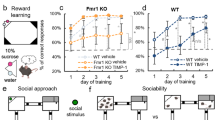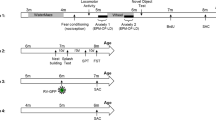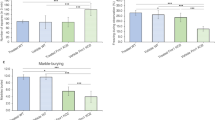Abstract
Aberrant neuronal translation is implicated in the etiology of numerous brain disorders. Although mTORC1-p70 ribosomal S6 kinase 1 (S6K1) signaling is critical for translational control, pharmacological manipulation in vivo has targeted exclusively mTORC1 due to the paucity of specific inhibitors to S6K1. However, small molecule inhibitors of S6K1 could potentially ameliorate pathological phenotypes of diseases, which are based on aberrant translation and protein expression. One such condition is fragile X syndrome (FXS), which is considered to be caused by exaggerated neuronal translation and is the most frequent heritable cause of autism spectrum disorder (ASD). To date, potential therapeutic interventions in FXS have focused largely on targets upstream of translational control to normalize FXS-related phenotypes. Here we test the ability of two S6K1 inhibitors, PF-4708671 and FS-115, to normalize translational homeostasis and other phenotypes exhibited by FXS model mice. We found that although the pharmacokinetic profiles of the two S6K1 inhibitors differed, they overlapped in reversing multiple disease-associated phenotypes in FXS model mice including exaggerated protein synthesis, inappropriate social behavior, behavioral inflexibility, altered dendritic spine morphology, and macroorchidism. In contrast, the two inhibitors differed in their ability to rescue stereotypic marble-burying behavior and weight gain. These findings provide an initial pharmacological characterization of the impact of S6K1 inhibitors in vivo for FXS, and have therapeutic implications for other neuropsychiatric conditions involving aberrant mTORC1-S6K1 signaling.
Similar content being viewed by others
Log in or create a free account to read this content
Gain free access to this article, as well as selected content from this journal and more on nature.com
or
References
American Psychiatric Association (2013) Diagnostic and Statistical Manual of Mental Disorders, 5th edn. Americal Psychiatric Publishing: Arlington, VA.
Bhattacharya A, Kaphzan H, Alvarez-Dieppa AC, Murphy JP, Pierre P, Klann E (2012). Genetic removal of p70 S6 kinase 1 corrects molecular, synaptic, and behavioral phenotypes in fragile X syndrome mice. Neuron 76: 325–337.
Bowling H, Bhattacharya A, Zhang G, Lebowitz JZ, Alam D, Smith P et al (2016). BONLAC: a combinatorial proteomic technique to measure stimulus-induced translational profiles in brain slices. Neuropharmacology 100: 76–89.
Costa-Mattioli M, Sossin WS, Klann E, Sonenberg N (2009). Translational control of long-lasting synaptic plasticity and memory. Neuron 61: 10–26.
Couty S, Westwood IM, Kalusa A, Cano C, Travers J, Boxall K et al (2013). The discovery of potent ribosomal S6 kinase inhibitors by high-throughput screening and structure-guided drug design. Oncotarget 4: 1647–1661.
Darnell JC, Klann E (2013). The translation of translational control by FMRP: therapeutic targets for FXS. Nat Neurosci 16: 1530–1536.
Eyre TA, Collins GP, Goldstone AH, Cwynarski K (2014). Time now to TORC the TORC? New developments in mTOR pathway inhibition in lymphoid malignancies. Br J Haematol 166: 336–351.
Gkogkas CG, Khoutorsky A, Cao R, Jafarnejad SM, Prager-Khoutorsky M, Giannakas N et al (2014). Pharmacogenetic inhibition of eIF4E-dependent Mmp9 mRNA translation reverses fragile X syndrome-like phenotypes. Cell Rep 9: 1742–1755.
Gross C, Chang CW, Kelly SM, Bhattacharya A, McBride SM, Danielson SW et al (2015a). Increased expression of the PI3K enhancer PIKE mediates deficits in synaptic plasticity and behavior in fragile X syndreome. Cell Rep 11: 727–736.
Gross C, Nakamoto M, Yao X, Chan CB, Yim SY, Ye K et al (2010). Excess phosphoinositide 3-kinase subunit synthesis and activity as a novel therapeutic target in fragile X syndrome. J Neurosci 30: 10624–10638.
Gross C, Raj N, Molinaro G, Allen AG, Whyte AJ, Gibson JR et al (2015b). Selective role of the catalytic PI3K subunit p110β in impaired higher order cognition in fragile X syndrome. Cell Rep 11: 681–688.
Hagerman RJ, McBogg P, Hagerman PJ (1983). The fragile X syndrome: history, diagnosis, and treatment. J Dev Behav Pediatr 4: 122–130.
Hoeffer CA, Klann E (2010). mTOR signaling: at the crossroads of plasticity, memory and disease. Trends Neurosci 33: 67–75.
Hoeffer CA, Sanchez E, Hagerman RJ, Mu Y, Nguyen DV, Wong H et al (2012). Altered mTOR signaling and enhanced CYFIP2 expression levels in subjects with fragile X syndrome. Genes Brain Behav 11: 332–341.
Holz MK (2012). The role of S6K1 in ER-positive breast cancer. Cell Cycle 11: 3159–3165.
Huynh TN, Santini E, Klann E (2014). Requirement of mammalian target of rapamycin complex 1 downstream effectors in cued fear memory reconsolidation and its persistence. J Neurosci 34: 9034–9039.
Kumari D, Bhattacharya A, Nadel J, Moulton K, Zeak NM, Glicksman A et al (2014). Identification of fragile X syndrome-specific molecular markers in human fibroblasts: a useful model to test the efficacy of therapeutic drugs. Hum Mutat 35: 1485–1494.
Lipton JO, Sahin M (2014). The neurology of mTOR. Neuron 84: 275–291.
Magnuson B, Ekim B, Fingar DC (2012). Regulation and function of ribosomal protein S6 kinase (S6K) within mTOR signalling networks. Biochem J 441: 1–21.
Michalon A, Sidorov M, Ballard TM, Ozmen L, Spooren W, Wettstein JG et al (2012). Chronic pharmacological mGlu5 inhibition corrects fragile X in adult mice. Neuron 74: 49–56.
Niwa H, Mikuni J, Sasaki S, Tomabechi Y, Honda K, Ikeda M et al (2014). Crystal structures of the S6K1 kinase domain in complexes with inhibitors. J Struct Funct Genomics 15: 153–164.
Osterweil EK, Chuang SC, Chubykin AA, Sidorov M, Bianchi R, Wong RK et al (2013). Lovastatin corrects excess protein synthesis and prevents epileptogenesis in a mouse model of fragile X syndrome. Neuron 77: 243–250.
Osterweil EK, Krueger DD, Reinhold K, Bear MF (2010). Hypersensitivity to mGluR5 and ERK1/2 leads to excessive protein synthesis in the hippocampus of a mouse model of fragile X syndrome. J Neurosci 30: 15616–15627.
Pearce LR, Alton GR, Richter DT, Kath JC, Lingardo L, Chapman J et al (2010). Characterization of PF-4708671, a novel and highly specific inhibitor of p70 ribosomal S6 kinase (S6K1). Biochem J 431: 245–255.
Pop AS, Levenga J, de Esch CE, Buijsen RA, Nieuwenhuizen IM, Li T (2013). Rescue of dendritic spine phenotype in Fmr1 KO mice with the mGluR5 antagonist AFQ056/mavoglurant. Psychopharmacology (Berl) 231: 1227–1235.
Richter JD, Bassell GJ, Klann E (2015). Dysregulation and restoration of translational homeostasis in fragile X syndrome. Nat Rev Neurosci 16: 595–605.
Santoro MR, Bray SM, Warren ST (2012). Molecular mechanisms of fragile X syndrome: a twenty-year perspective. Annu Rev Pathol 7: 219–245.
Selman C, Tullet JM, Wieser D, Irvine E, Lingard SJ, Choudhury AI et al (2009). Ribosomal protein S6 kinase 1 signaling regulates mammalian life span. Science 326: 140–144.
Sharma A, Hoeffer CA, Takayasu Y, Miyawaki T, McBride SM, Klann E et al (2010). Dysregulation of mTOR signaling in fragile X syndrome. J Neurosci 30: 694–702.
Shima H, Pende M, Chen Y, Fumagalli S, Thomas G, Kozma SC (1998). Disruption of the p70(s6k)/p85(s6k) gene reveals a small mouse phenotype and a new functional S6 kinase. EMBO J 17: 6649–6659.
Sidhu H, Dansie LE, Hickmott PW, Ethell DW, Ethell IM (2014). Genetic removal of matrix metalloproteinase 9 rescues the symptoms of fragile X syndrome in a mouse model. J Neurosci 34: 9867–9879.
Tolcher A, Goldman J, Patnaik A, Papadopoulos KP, Westwood P, Kelly CS et al (2014). A phase I trial of LY2584702 tosylate, a p70 S6 kinase inhibitor, in patients with advanced solid tumours. Eur J Cancer 50: 867–875.
Udagawa T, Farny NG, Jakovcevski M, Kaphzan H, Alarcon JM, Anilkumar S et al (2013). Genetic and acute CPEB1 depletion ameliorate fragile X pathophysiology. Nat Med 19: 1473–1477.
Acknowledgements
The authors would like to acknowledge the technical assistance provided by Ms Nicole Zeak at Center for Neural Science at New York University and Ms Kari Fonseca at Pfizer Neuroscience.
Author information
Authors and Affiliations
Corresponding author
Additional information
Supplementary Information accompanies the paper on the Neuropsychopharmacology website
Supplementary information
Rights and permissions
About this article
Cite this article
Bhattacharya, A., Mamcarz, M., Mullins, C. et al. Targeting Translation Control with p70 S6 Kinase 1 Inhibitors to Reverse Phenotypes in Fragile X Syndrome Mice. Neuropsychopharmacol 41, 1991–2000 (2016). https://doi.org/10.1038/npp.2015.369
Received:
Revised:
Accepted:
Published:
Issue date:
DOI: https://doi.org/10.1038/npp.2015.369
This article is cited by
-
Autism-like social deficit generated by Dock4 deficiency is rescued by restoration of Rac1 activity and NMDA receptor function
Molecular Psychiatry (2021)
-
A human forebrain organoid model of fragile X syndrome exhibits altered neurogenesis and highlights new treatment strategies
Nature Neuroscience (2021)
-
Controlled trial of lovastatin combined with an open-label treatment of a parent-implemented language intervention in youth with fragile X syndrome
Journal of Neurodevelopmental Disorders (2020)
-
Excessive Homeostatic Gain in Spinal Motoneurons in a Mouse Model of Amyotrophic Lateral Sclerosis
Scientific Reports (2020)
-
Altered steady state and activity-dependent de novo protein expression in fragile X syndrome
Nature Communications (2019)



